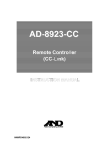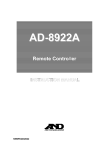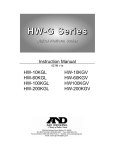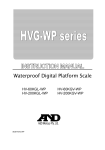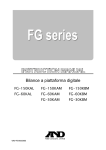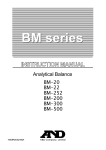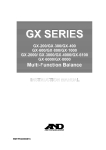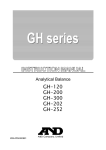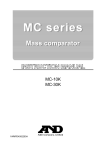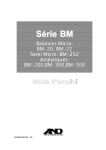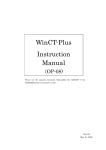Download A&D AD-8922A Instruction manual
Transcript
AD-4212C-300 AD-4212C-600 AD-4212C-3000 AD-4212C-6000 AD-4212C-301 AD-4212C-3100 Production Weighing Unit INSTRUCTION MANUAL 1WMPD4001992B © 2011 A&D Company, Limited. All rights reserved. No part of this publication may be reproduced, transmitted, transcribed, or translated into any language in any form by any means without the written permission of A&D Company, Limited. The contents of this manual and the specifications of the instrument covered by this manual are subject to change for improvement without notice. Windows and Excel are registered trademarks of Microsoft Corporation. . CONTENTS 1. INTRODUCTION ..........................................................................................................................2 1.1. Features ........................................................................................................................................ 2 1.2. Compliance ................................................................................................................................... 5 2. UNPACKING THE BALANCE .....................................................................................................6 2.1. Unpacking...................................................................................................................................... 6 2.2. Installing the Balance .................................................................................................................... 8 3. PRECAUTIONS .........................................................................................................................10 3.1. Before Use .................................................................................................................................. 10 3.2. When Building Into a System .......................................................................................................11 3.3. During Use .................................................................................................................................. 14 3.4. After Use...................................................................................................................................... 14 3.5. Power Supply .............................................................................................................................. 14 4. OPERATION OF WinCT-AD4212C ...........................................................................................15 4.1. Changing the Weighing Speed Using WinCT-AD4212C ................................................................... 16 4.2. Calibration ................................................................................................................................... 16 4.3. Changing the Baud Rate Using WinCT-AD4212C............................................................................ 18 5. SMART RANGE FUNCTION .....................................................................................................19 6. COMMUNICATION SPECIFICATIONS......................................................................................20 7. MAINTENANCE .........................................................................................................................25 8. TROUBLESHOOTING ...............................................................................................................26 8.1. Checking the Balance Performance and Environment ............................................................... 26 8.2. Asking For Repair........................................................................................................................ 27 9. SPECIFICATIONS......................................................................................................................28 10. EXTERNAL DIMENSIONS .....................................................................................................30 11. OPTIONS................................................................................................................................31 12. TERMS/INDEX .......................................................................................................................33 1 1. INTRODUCTION This manual describes how the AD-4212C series balance works and how to get the most out of it in terms of performance. Read this manual thoroughly before using the balance and keep it at hand for future reference. 1.1. Features z A Weighing Unit, suitable for building into a production line system. The weighing unit is compact, with a width of 59 mm. z A Super Hybrid Sensor (SHS) is used to provide high resolution and high response speed. Minimum weighing Stabilization time*1 value AD-4212C-300 320 g 0.001 g 0.5 second (0 - 30 g), 1.0 second (30 - 320 g) AD-4212C-600 620 g 0.001 g 0.5 second (0 - 30 g), 1.0 second (30 - 620 g) AD-4212C-3000 3200 g 0.01 g 0.5 second (0 - 300 g), 1.0 second (300 - 3200 g) AD-4212C-6000 6200 g 0.01 g 0.5 second (0 - 300 g), 1.0 second (300 - 6200 g) 51 g*2 0.0001 g 1.3 seconds AD-4212C-301 320 g 0.001 g 1.0 second 510 g*2 0.001 g 1.3 seconds AD-4212C-3100 3200 g 0.01 g 1.0 second *1 With FAST selected under good environment *2 Smart range (Refer to “5. SMART RANGE FUNCTION”.) Model Weighing capacity z The AD-4212C series can output the weighing digital data directly. Therefore, the AD-4212C series (the weighing unit) can be connected to a personal computer or a PLC directly. z Dust-protected and Protected Against Splashing Water (Complying with IP65). The AD-4212C series has a patented shock absorber under the weighing pan and can cope with movement in all directions, protecting the weighing unit from an actuator malfunction. z Windows Communication Tools (WinCT-AD4212C), allows easy confirming of the weighing data by using a Windows-based personal computer. Windows is a registered trademark of the Microsoft Corporation. z When connected to an optional remote controller, an AD-8922A, AD-8923-BCD or AD-8923-CC, the remote controller can receive the weighing data and manually perform re-zero and calibration. The AD-8922A can output the data using BCD, comparator or analog out by selection of the option installed in the AD-8922A. The AD-8923-BCD outputs the data using BCD and the AD-8923-CC outputs the data using CC-Link. Note: CC-Link is a high-speed field network able to simultaneously handle both control and information data. z When connected to an optional AD-8526 Ethernet converter, it can convert the AD-4212C RS-232C data, for output to a local area network (LAN). 2 Example 1 (Connecting to a personal computer or an AD-8922A) AD-4212C Accessory RS-232C cable (10 m) Communication software “ WinCT-AD4212C” USB converter (Option: AX-USB-9P) USB port Personal computer AD-8922A AD-4212C USB converter (Option: AX-USB-9P) Accessory RS-232C cable (10 m) Communications cable (Option: AX-KO1786-200) 3 Personal computer Example 2 (Connecting to a PLC) . D-sub 9-pin (female) AD-4212C Accessory RS-232C cable (10 m) PLC AD-8922A-01 Connection cable* AD-4212C BCD input AD-8922A PLC BCD output board (Option AD-8922A-01) BCD cable (Fabricate locally) * Specify the AD-8922A-01 connection cable when ordering the AD-8922A-01. AX-KO3705-200 AX-KO3705-500 AX-KO3705-1000 2m 5m 10 m AD-8923-CC AD-4212C CC-Link network Accessory RS-232C cable (10 m) To other remote stations PLC AD-4212C Accessory RS-232C cable (10 m) LAN port AD-8526 LAN cable 4 PLC 1.2. Compliance Compliance with FCC Rules Please note that this equipment generates, uses and can radiate radio frequency energy. This equipment has been tested and has been found to comply with the limits of a Class A computing device pursuant to Subpart J of Part 15 of FCC rules. These rules are designed to provide reasonable protection against interference when the equipment is operated in a commercial environment. If this unit is operated in a residential area, it may cause some interference and under these circumstances the user would be required to take, at his own expense, whatever measures are necessary to eliminate the interference. (FCC = Federal Communications Commission in the U.S.A.) Compliance with EMC Directives This device features radio interference suppression in compliance with valid EC Regulation 2004/108/EEC. 5 2. UNPACKING THE BALANCE 2.1. Unpacking The balance is a precision instrument. Unpack the balance carefully. Keep the packing material to be used for transporting the balance in the future. When unpacking, see the illustration below to confirm that everything is contained. AC adapter jack Weighing pan Screws (Flat head: M4 X 6) Pan support RS-232C connector AC adapter plug Grounding terminal (See note below.) Arrow mark face up Pan support boss RS-232C cable (10 m) Breeze break Weighing unit Leveling foot Accessories Windows communication tools (WinCT-AD4212C) ● RS-232C cable (10 m)*2 Weighing pan Pan support ● Screws (Flat head: M4 X 6) ● ● *1 AC adapter Calibration weight 200 g OIML, Class E2 or equivalent AC adapter ID label *1 Please confirm that the AD adapter type is correct for your local voltage and receptacle type. *2 2-m and 5-m cables are available as options. Refer to "10. OPTIONS". Note When the AD-4212C series weighing unit is built into a system, be sure to earth ground the weighing unit using the grounding terminal. 6 ATTACHING THE AD-4212C SERIES WEIGHING UNIT DIRECTLY ON THE MOUNTING BASE When the AD-4212C series weighing unit is built into a system, remove the three leveling feet and use the screw holes to secure the weighing unit to the base. Attachment Procedure 1. Remove the three leveling feet. Caution Do not remove any other screws from the bottom of the weighing unit. Doing so could damage the weighing sensor. Weighing unit 2. Secure the weighing unit from above. (Prepare appropriate screws with a size corresponding to an M5 screw. The screw hole diameter: 6 mm). Leveling foot In case of securing the weighing unit from the under side, use M6 screws with 1-mm pitch. To secure Notes The screws to secure the weighing unit to the mounting base are not provided. For the position of the holes, refer to “10. EXTERNAL DIMENSIONS”. When the leveling adjustment is difficult to perform due to the installation conditions, place a shim between the lower surface of the weighing unit and the securing surface, or use two nuts. If the adjustment is still difficult to perform, perform calibration before use. Then, the balance will function normally. 7 2.2. Installing the Balance Install the balance as follows: 1. Refer to “3. PRECAUTIONS” for installing the balance. 2. Refer to "2-1 Unpacking" on page 6, to attach the pan support and the weighing pan on the weighing unit. 3. Insert the RS-232C cable into the jack located on the rear of the weighing unit. Rear of the weighing unit When confirming the performance of the weighing unit using WinCT-AD4212C, connect the cable into RS-232C terminal of the computer. Arrow mark face up D-sub 9-pin RS-232C cable How to disconnect the cable from the weighing unit Slide the connector sleeve in the direction of the arrow to unlock and gently pull the connector out. Unlocked Slide the connector sleeve in the direction of the arrow 4. Confirm that the AC adapter type is correct for the local voltage and power receptacle type. 5. Plug the AC adapter plug into the AC adapter jack located on the rear of the weighing unit and plug the AC adapter into the electrical outlet. Warm up the balance for 30 minutes or more with nothing on the weighing pan. 6. Set the pan unit and I/O unit to adapt to the peripheral system. Set the following for the I/O unit. RS-232C (Refer to“6. COMMUNICATION SPECIFICATIONS”) Set the weighing speed to adapt to the ambient conditions. Note Make sure that the personal computer is in operation before connecting to the AD-4212C. 7. After the balance has been installed, calibrate the balance using the 200 g calibration weight provided with the balance. For details, refer to “4.2. Calibration”. (The AD-4212C-3000/6000/3100 can be calibrated using the 200 g weight.) 8. By removing the provided weighing pan, a locally fabricated weighing pan can be attached to the AD-4212C series by using the four screw holes (M4 screw x pitch 0.7 mm) on the pan support. 8 MASS OF THE LOCALLY FABRICATED WEIGHING PAN Design the weighing pan so that the mass falls within the ranges shown in the table below: Model Mass of the weighing pan (g) 20 to 130 Status Pan support is used (with weighing pan removed) Pan support boss is used (with the weighing pan and pan support removed) Pan support is used (with weighing pan removed) AD-4212C-600 Pan support boss is used (with the weighing pan and pan support removed) Pan support is used (with weighing pan removed) AD-4212C-3000/3100 Pan support boss is used (with the weighing pan and pan support removed) Pan support is used (with weighing pan removed) AD-4212C-6000 Pan support boss is used (with the weighing pan and pan support removed) AD-4212C-300/301 AD-4212C-300/301 When the weighing pan is removed 320 g 20 g Mass range 210 g to be weighed 130 g Mass of locally fabricated pan 3200 g 20 g Mass range 210 g to be weighed Mass range 210 g to be weighed 620 g Mass of locally fabricated pan 20 g 20 to 6010 70 to 6060 Mass range 210 g to be weighed Mass of locally fabricated pan When the weighing pan and pan support are removed 620 g Mass range 210 g to be weighed 460 g Mass of locally 70 g fabricated pan When the weighing pan is removed Mass range 210 g to be weighed Mass of locally 70 g fabricated pan 70 to 3060 AD-4212C-6000 When the weighing pan and pan support are removed 3010 g 20 to 3010 410 g 180 g Mass of locally 70 g fabricated pan 3200 g 70 to 460 When the weighing pan is removed AD-4212C-3000/3100 When the weighing pan is removed 20 to 410 AD-4212C-600 When the weighing pan and pan support are removed 320 g 70 to 180 6200 g Mass range 210 g to be weighed When the weighing pan and pan support are removed 6200 g Mass range 210 g to be weighed 6010 g 3060 g 20 g Mass of locally fabricated pan 6060 g Mass of locally 70 g fabricated pan Notes If the balance is to be used in a range other than shown above, contact the local A&D dealer. To avoid the effects of static electricity or magnetism, use materials other than resin or magnetic materials when designing a weighing pan. When a locally fabricated weighing pan is used, the zero point may be shifted greatly right after the AC adapter is plugged in. Perform re-zero before weighing to cancel the amount of zero drift as necessary. 9 3. PRECAUTIONS To get the optimum performance from the balance and acquire accurate weighing data, note the following: 3.1. Before Use Install the weighing unit in an environment where the temperature and humidity are not excessive. The best operating temperature is about 20°C / 68°F at about 50% relative humidity. Install the weighing unit where it is not exposed to direct sunlight and it is not affected by heaters or air conditioners. Install the weighing unit where it is free of dust. Install the weighing unit away from equipment which produces magnetic fields. Install the weighing unit in a stable place avoiding vibration and shock. Corners of rooms on the first floor are best, as they are less prone to vibration. Ensure a stable power source when using the AC adapter. Plug in the AC adapter as usual, and warm up the balance for 30 minutes or more. Calibrate the balance before use or after having moved it to another location. In addition, calibrate it periodically to maintain the accuracy. Caution Do not install the balance where flammable or corrosive gas is present. 10 3.2. When Building Into a System The AD-4212C is a precision balance. When it is built into a system, errors such as unstable weight values may occur due to static electricity, vibration, sample temperature and magnetism of the materials weighed or used for the devices near the balance. When using the balance as part of a system, take the following precautions: z Precautions when not performing the weighing at the center of the weighing pan If not performing the weighing at the center of the weighing pan, design the weighing system so that the total moment of the support device and the object to be weighed will be the value specified in the table below. Even a load, with a moment of less than the specified value, when applied to the balance, may cause the overload protection mechanism to function slowly, to tilt the weighing pan. Allowable eccentric load for each model Model AD-4212C-300/600/301 AD-4212C-3000/6000/3100 Allowable eccentric load 0.1 Nm or less 0.3 Nm or less AD-4212C-300/600/301 Example of a system where the total moment of the device and the object is 0.1 Nm or less: 200 g X 0.05 m AD-4212C-3000/6000/3100 Example of a system where the total moment of the device and the object is 0.3 Nm or less: 300 g X 0.1 m Note: The values above are for reference and may be different from actual specifications. 11 Errors due to a static charge and measures to take When the ambient humidity is less than 45% RH, insulators such as plastic or glass are prone to static electricity. When charged material comes close to the balance, a pulling force is generated by static induction between the charged material and the weighing pan. This causes an unstable weight value. To protect the balance against a discharge generated by charged material when it comes close to the balance, be sure to earth ground the weighing unit and the display unit. Note that static electricity generated by static induction will not be canceled by earth-grounding. Use a humidifier or the AD-1683 DC static eliminator, Charged plastic breeze break Charged sample The pulling force causes an unstable weight value A pulling force generated between the charged sample and the balance causes an unstable weight value. Measures to take (Plastic is used in the examples below. They can be applied to glass, too.) When the sample or devices are plastic Use a static eliminator that generates no air blow such as the AD-1683, DC static eliminator, to remove static electricity. Place the sample in a container that is made of a conductive material such as metal and that can be sealed, and then weigh it. When the sample is powdery When the balance is used in combination with a feeder for batch weighing of powdery samples, samples may be charged by rubbing sample particles against each other. Use a static eliminator and perform weighing while removing static electricity. Charged material Metal case Grounding When the sample container is made of material that is prone to static electricity such as plastic Cover the outside of the container with a metal such as aluminum foil. Apply an anti-static agent onto the container. When making a breeze break using plastic Apply an anti-static agent onto the breeze break. Use a conductive acrylic fiber. When plastic exists in the balance installation site Cover the plastic with a grounded conductive material. Apply an anti-static agent onto the plastic. When an operator is static charged If an operator’s clothes are static charged, especially in winter, it may be a cause for unstable weight values. Wear an anti-static wrist strap. 12 Errors due to air flow and measures to take Where the influence of ambient air flow is great such as: close to an air conditioner, door or passage way. Even very subtle air flow that is hard to be detected may influence the weighing operation. Avoid those areas as a weighing site. If weighing is to be performed in such an area, use a breeze break or take other appropriate measures. Where the influence of heat or drafts is great Eliminate temperature differences Draft between a sample and the environment. 40 C When a sample is warmer (cooler) than 20 C the ambient temperature, the sample will be lighter (heavier) than the true weight. This error is due to a rising (falling) draft around the sample. Do not touch the sample directly with your hand. Use tweezers or other tools. If you touch the sample, the same type error described above will occur. Do not perform weighing where it is exposed to direct sunlight. Weighing errors may occur due to sudden temperature change or drafts. Errors due to vibration and measures to take Where the influence of vibration is great, such as: (1) Soft ground (2) Second or higher floor (3) Near center of a floor far from pillars (4) Seismic isolated structures (5) Near tall buildings. In the areas listed above, the scale may yield unstable weight values on windy days or after an earthquake. Especially in case of (4) and (5), weight values may be unstable for a long period of time because of long lasting low-frequency vibration after strong winds or an earthquake. Errors due to other causes and measures to take Change in temperature or humidity A sudden change in temperature or humidity can generate a draft and cause the balance to absorb or exude moisture, which leads to unstable displays. Avoid sudden change in temperature or humidity. Use an air conditioner or humidifier to control the temperature or humidity. Magnetic material The balance uses a strong magnet as part of the balance assembly, so use much care when weighing magnetic materials. Place a non-magnetic object such as aluminum or brass between the sample and the balance to keep an appropriate distance between them while weighing. 13 3.3. During Use To minimize the affect by electrical noises, earth ground the weighing unit and the display unit (option). Do not drop things upon the weighing pan, or place a sample on the pan that is beyond the balance weighing capacity. Place a sample in the center of the weighing pan to minimize corner-load errors. To prevent possible errors, before each weighing, perform re-zero using the RS-232C command, or calculate the difference between the weight value before and after weighing. Take into consideration the affect of air buoyancy on a sample when measuring the absolute value with the minimum weighing value of 0.1 mg. Even though the scale is dust-protected and protected against splashing water, complying with IP65, be sure to clean the weighing pan and keep the conditions around the pan clean after weighing powdery, fluid samples or metallic strips. 3.4. After Use Avoid mechanical shock to the weighing unit. Periodically calibrate the balance, using a calibration weight,. Do not disassemble the weighing unit. Contact the local A&D dealer if the balance needs service or repair. Do not use organic solvents to clean the weighing unit. Clean the weighing unit with a lint free cloth that is moistened with warm water and a mild detergent. Avoid dust and water so that the weighing unit weighs correctly. Protect the internal parts from liquid spills and excessive dust. 3.5. Power Supply When the AC adapter is connected, the balance is in the standby mode if the standby indicator is on (refer to “4. OPERATION OF WinCT-AD4212C”). This is a normal state and does not harm the balance. For accurate weighing, plug in the AC adapter and warm up the balance for the appropriate duration before use. 14 4. OPERATION OF WinCT-AD4212C The software has the following functions: - Set the weighing speed - Set the minimum display value - Calibration - Set the baud rate • The parameters set using these functions, are stored in non-volatile memory, and maintained, even if the AC adapter is removed,. - A data logging function, allows confirmation of the weighing data after weighing Before use 1. Install the WinCT-AD4212C into the computer. For details, refer to Readme of WinCT-AD4212C. 2. Connect one end of the RS-232C cable to the weighing unit RS-232C connector and connect the other end of the RS-232C cable (D-sub 9-pin) to the personal computer RS-232C terminal. 3. Set the COM port of the WinCT-AD4212C on the personal computer, and press the START button. The personal computer will display the weight value. Function of display symbols and buttons Weighing speed indicators Processing indicator Stabilization indicator Standby indicator Unit (g) Weighing data or stored data Button When pressed SAMPLE Switches between the weighing mode and the standby mode. With the standby mode, only the standby indicator is displayed. The ON/OFF button is available anytime. Therefore, if you press the ON/OFF button when operating, the balance switches to the standby mode. In the weighing mode, switches the minimum weighing value. MODE Changes the weighing speed. CAL Enters the calibration mode. PRINT (Usually no function. Used in the calibration mode.) RE-ZERO Sets the display to zero. ON/OFF 15 4.1. Changing the Weighing Speed Using WinCT-AD4212C The weighing speed can be selected from the following three rates to minimize the influence on weighing that is caused by drafts and/or vibration at the place where the balance is installed. Indicator FAST MID. SLOW Speed Fast Slow Weighing speed setting Stability Sensitive value Stable value Operation MODE 1. Press the MODE button. 2. Press the MODE button to select a weighing speed. Either FAST, MID. or SLOW can be selected. MODE Each pressing switches the indicators 4.2. Calibration Calibration Calibration using the calibration weight. Caution Do not allow vibration or drafts to affect the balance during calibration. Caution on using an external calibration weight The accuracy of the weight can influence the accuracy of weighing. Select an appropriate weight as listed below. A calibration weight (conforming to OIML, Class E2 or equivalent) is provided with the balance as a standard accessory. Model AD-4212C-300 AD-4212C-600 Usable calibration weight 50g, 100g, 200 g, 300g 50g, 100g, 200 g, 300g, 400 g, 500 g, 600 g 50g, 100g, 200 g, 300g, 400 g, 500 g, 1000 g, AD-4212C-3000 2000g, 3000g 200 g, 500 g, 1000 g, 2000g, 3000g, 4000 g, AD-4212C-6000 5000 g, 6000 g AD-4212C-301 50g, 100g, 200 g, 300g 50g, 100g, 200 g, 300g, 400 g, 500 g, 1000 g, AD-4212C-3100 2000g, 3000g The calibration weight in bold type: factory setting Calibration weight provided 200 g Display This indicator means “the balance is measuring calibration data”. Do not allow vibration or drafts to affect the balance while this indicator is displayed. 16 Calibration procedure This function calibrates the balance using the calibration weight. (Display example: AD-4212C-300) Operation 1. Plug in the AC adapter and warm up the balance for 30 minutes or more with nothing on the pan. 2. Press the CAL button. Cal 0 is displayed. Press CAL If you want to cancel calibration, press the CAL button. The balance will return to the weighing mode. If you want to change the calibration mass value, press the SAMPLE button. Press the RE-ZERO button to select the mass value, and press the PRINT button to store it. Cal 0 is displayed. 3. Confirm that there is nothing on the pan and press the PRINT button. The balance measures the zero point. Do not allow vibration or drafts to affect the balance. The balance displays the calibration weight value. 4. Place a calibration weight, of the weight value displayed, on the pan and press the PRINT button. The balance measures the calibration weight. Do not allow vibration or drafts to affect the balance. 5. The balance displays end . Remove the weight from the pan. 6. The balance will automatically return to the weighing mode. 7. Place the calibration weight on the pan and confirm that calibration was performed correctly. If not, check the ambient conditions such as drafts or vibration, and repeat steps 2 through 7. 17 Press PRINT Calibration weight Press PRINT 4.3. Changing the Baud Rate Using WinCT-AD4212C Operation 1. Click the [Settings] tab. 2. Select the baud rate to be used and click the Set [Settings] tab Set button 3. “Completed” appears when the setting is complete. 18 button. (Factory setting: 2400) 5. SMART RANGE FUNCTION The AD-4212C-301/3100 are equipped with two ranges. The precision range has a higher resolution. The standard range has a normal resolution. The range switches automatically, depending on the value displayed. Sending the R command allows weighing in the precision range, regardless of the tare value. The range can be fixed to the standard range by changing the minimum weighing value using the SMP command. Display example: AD-4212C-301 1 Send the R command The balance will start weighing, using the precision range. 2 Place a container on the weighing pan. The weight value exceeds the precision range value and the balance will switch to the standard range. Weighing pan Precision range Container Standard range Precision range 3 Send the R command The balance will switch to the precision range. 4 Place a sample in the container. The weight value is within the precision range value and the balance will perform a weighing, using the precision range. Sample Precision range Precision range/standard range Model AD-4212C-301 AD-4212C-3100 Range used Precision range*1 Standard range Precision range*2 Standard range Weighing range 0g 51 g 0g 510 g to 51 g to 320 g to 510 g to 3200 g Available minimum weighing value 0.0001 g 0.001 g 0.001 g 0.01 g • The factory setting is the precision range. *1 When the weight value exceeds 51 g while the minimum weighing value of 0.0001 g (precision range) is used, the balance will switch to the minimum weighing value of 0.001 g (standard range). By sending the R command, the balance can weigh from that point up to 51 g, using the minimum weighing value of 0.0001 g (precision range). *2 When the weight value exceeds 510 g while the minimum weighing value of 0.001 g (precision range) is used, the balance will switch to the minimum weighing value of 0.01 g (standard range). By sending the R command, the balance can weigh from that point up to 510 g, using the minimum weighing value of 0.001 g (precision range). 19 6. COMMUNICATION SPECIFICATIONS The AD-4212C series can communicate interactively using RS-232C. The AD-4212C series can continuously transmit the weighing data. (Approx.10 times/second* to 50 times/second) The AD-4212C series is DCE. The AD-4212C series can connect directly to the RS-232C terminal of a personal computer by using the accessory RS-232C cable. * Factory setting 1. RS-232C specification Transmission system Transmission form Transmission rate Data format EIA RS-232C Asynchronous, bi-directional, half duplex Approx.10 times/second* to 50 times/second Baud rate 2400bps* to 19200bps Data bits 7 bits Parity EVEN Stop bit 1 bits Code ASCII Terminator <CR><LF> * Factory setting LSB Start bit MSB Data bits Stop bit Parity bit Relation between baud rate and transmission rate of weighing data Transmission rate of weighing data Baud rate 2400bps 12.5 times/second 4800bps 25.0 times/second 9600bps 50.0 times/second 19200bps 50.0 times/second 20 1 -5V to -15V 0 +5V to +15V 2. Pin position Pin position of the RS-232C cable (D-Sub 9-pin side, female) 5 1 Inch screw 9 6 Pin No. Signal name Direction 1 (Vs) - 2 TXD Output 3 RXD Input 4 5 6 7 8 SG RTS CTS Input Output Description Internally used* (Power supply GND terminal for external equipment) Transmit data Receive data N.C. Signal ground Internally used* Request to send Permission to send Internally used* (Power supply output terminal for external 9 (Va) equipment CTS and RTS are internally connected in the balance. The AD-4212C can communicate by connecting TXD, RXD and SG. * When connecting to a PLC such as the external equipment, do not connect to the internally used signal line. 3. Data output format - This format consists of fifteen characters excluding the terminator<CR><LF>. - A header of two characters indicates the balance condition. - The polarity sign is placed before the data with the leading zeros. If the data is zero, the plus sign is applied. Example of output 1 2 3 4 5 6 7 8 9 10 11 12 S T , + 0 0 1 2 . 3 4 5 Header 13 14 15 g Data Unit When stable S T , + 0 0 1 2 . 3 4 5 g , + 0 0 0 5 . 4 3 2 g 9 9 9 9 9 9 E + 1 9 9 9 9 9 9 9 E + 1 9 When unstable U S When over state (plus over) O L , + 9 When over state (minus over) O L , - 9 21 4. Command The balance can be controlled by the following commands. When transmitting, add the terminator <CR><LF> to each command. Commands to query weighing data When the display is turned on, the AD-4212C series outputs the weighing data continuously. To use the Q or S command, send the C command to stop the continuous data output, then request the weighing data using the Q or S command. Command C Q S SIR Description Cancels the SIR command. Requests the weighing data immediately. (Outputs data regardless of the display condition, stable or unstable. Use this command while the continuous output is stopped.) Requests the weighing data when stabilized. (After the weighing data has stabilized, outputs the data. Use this command while the continuous output is stopped.) Requests the weighing data continuously. Starts the continuous output of the weighing data. (The C command stops the continuous output.) Commands to control the balance Command CAL OFF ON P PRT R SMP U Description *1 Enters the calibration mode. Turns the display off. The weighing unit is in the standby mode. Turns the display on. The weighing unit is in the weighing mode. Switches between the weighing mode and the standby mode. Confirms the calibration value. Sets the display to zero (tare). *2 Changes the minimum display. Changes the weighing speed. *1 *1 When changing the weighing speed or in the calibration mode, the balance outputs the control character starting with “@”. *2 When setting the display to zero, the command waits for the weight value to become stable. When the command waits for the weight value to become stable, the balance stops sending the weighing data. R command example Personal computer Time Weighing unit S R command T , + 0 0 0 0 . 0 1 2 g 0 g R CR LF (Stops the data output) S T , 22 + 0 0 0 0 . 0 0 CAL command example External devices Time Weighing unit (PC, PLC) CAL command C A L CR LF S T , + 0 0 @ R E ; 0 0 @ D P ; 0 0 0 @ S T 0 0 ; 0 0 . 0 1 2 g @ C H ; @ C H ; C A L 0 PRT command P R T CR LF Weighing the zero point Place the calibration weight ; 0 4 Being weighed @ R E ; 0 0 @ D P ; 0 0 0 @ S T 0 0 @ S T ; @ C H ; @ C H ; 2 0 0 Displays the calibration weight value PRT command P R T CR LF ; 0 4 Calibration weight being weighed @ R E ; 0 0 @ D P ; 0 0 0 @ S T 0 0 @ S T ; @ C H ; E N D Displays "END". @ C H ; After the weight is removed, the balance returns to the weighing mode. @ R E ; 0 0 @ D P ; 0 0 0 @ S T 0 0 @ D P ; 0 0 4 S T , + 0 0 0 0 . 0 0 0 g S T , + 0 0 0 0 . 0 0 0 g ; @ C H ; 23 SMP command example Personal computer Time Weighing unit S T , + SMP command S M P CR LF S T , 0 0 + 0 0 0 0 0 . 0 1 2 g . 0 1 g 0 0 0 g 4 g 0 0 R command example when the precision range is used Personal computer Time Weighing unit S T , + 0 0 0 . 0 The weight value exceeds 51 g. S T , + R command 0 0 5 1 . 2 3 R CR LF (While waiting for the weight value to become stable, stops the data output) S T , + 0 0 0 . 0 0 0 0 g 1 . 2 3 4 5 g Place a sample. S T , + 24 0 0 7. MAINTENANCE Do not disassemble the balance. Contact the local A&D dealer if the balance needs service or repair. Use the original packing material for transportation. Do not use organic solvents to clean the balance. Clean the balance with a lint free cloth that is moistened with warm water and a mild detergent. 25 8. TROUBLESHOOTING 8.1. Checking the Balance Performance and Environment The balance is a precision instrument. When the operating environment or the operating method is inadequate, performing accurate weighing will not be possible. If the balance seems to have a problem with repeatability or to perform improperly, check as described below. Also, visit our website, http://www.aadd.co.jp/, for “Information Library” and “FAQ”. If improper performance persists, contact the local A&D dealer for repair. Checking that the balance performs properly Check the balance repeatability using the calibration weight. Be sure to place the weight in the center of the weighing pan. Pay attention to the air flow. Use the breeze break, or cover the balance if necessary. Check the balance repeatability, linearity and calibrated value using external weights with a known value. When the balance is built into a system, remove the balance from the system. Place it on a solid table and perform checking. When the balance proper performance is confirmed, refer to page 11 to set up the installation site. Checking that the operating environment or weighing method is proper Operating environment Is the weighing table solid enough? Is the operating environment free from vibration and drafts? Has the breeze break been installed? Is there a strong electrical or magnetic noise source such as a motor near the balance? Is there a heat source near the balance? Weighing method Does the weighing pan touch the breeze break or anything? Is the weighing pan installed correctly? Has the weight value been set to zero by using an RS-232C command (R command) before placing a sample on the weighing pan? Is the sample placed in the center of the weighing pan? Has the balance been warmed up for 30 minutes or more before weighing? Are the leveling feet of the weighing unit placed flat to the installation surface? If not, the weight value will be unstable or the specified repeatability can not be obtained. Improve the installation condition, by securing the weighing unit or reducing the vibration that is conveyed to the weighing unit. 26 Sample and container Has the sample absorbed or lost moisture? Has the temperature of the sample, and the container if used, been allowed to equalize to the ambient temperature? Refer to “3-2 When Building into a System”. Is the sample charged with static electricity? Refer to “3-2 When Building into a System”. Is the sample of magnetic material such as iron? Use much care when weighing magnetic materials. Refer to “3-2 When Building into a System”. 8.2. Asking For Repair If the balance needs service or repair, contact the local A&D dealer. The balance is a precision instrument. Use much care when handling the balance and observe the following when transporting the balance. Use the original packing material. Remove the weighing pan from the weighing unit. 27 9. SPECIFICATIONS AD-4212C-300 AD-4212C-600 Weighing capacity 320 g 620 g Maximum display 320.084 g 620.084 g 320.084 g / 51.0009 g Minimum weighing value (1 digit) 0.001 g 0.001 g 0.001 g / 0.0001 g Repeatability (Standard deviation) 0.001 g 0.001 g 0.001 g / 0.0002 g ±0.002 g ±0.005 g Linearity Stabilization time in seconds (typical at FAST under good environment) Display refresh rate I/O unit RS-232C Sensitivity drift AD-4212C-301 *1 320 g / 51 g 0-30 g 0.5 s 0-30 g 0.5 s 30-320 g 1.0 s 30-620 g 1.0 s ±0.002 g When the minimum weighing value of 0.0001 g is selected When the minimum weighing value of 0.001 g is selected 1.3 s *2 1.0 s Approx.10 times/second* to 50 times/second Bi-directional, 2400 bps* to 19200 bps (WinCT-AD4212C communication software provided) ±2 ppm/°C (10°C to 30°C/50°F to 86°F ) Operating environment 5°C to 40°C (41°F to 104°F), 85% RH or less (No condensation) Allowable eccentric load 0.1 Nm or less (With the center of the weighing pan as a reference) Calibration weight provided 200g (Conforming to OIML Class E2) Applicable weight values 50 g, 100 g, 50 g, 100 g, 50 g, 100 g, 200 g*, 300g 200 g*, 300g, 200 g*, 300g 400 g, 500 g, 600 g Weighing Dimensions 59 (W) × 231 (D) × 91 (H) mm Weighing pan 50 × 50 mm Mass Approx. 1.6 kg Connection cable Approx. 10 m unit Unit display mode AC adapter Power consumption *1 *2 Gg Output voltage 12V (Confirm that the adapter type is correct for the local voltage and power receptacle type) Approx. 10VA (supplied to the AC adapter) Smart range (Refer to “5. SMART RANGE FUNCTION”.) When the precision range is used * Factory setting 28 AD-4212C-3100 AD-4212C-3000 AD-4212C-6000 Weighing capacity 3200 g 6200 g Maximum display 3200.84 g 6200.84 g 3200.84 g / 510.009 g Minimum weighing value (1 digit) 0.01 g 0.01 g 0.01 g / 0.001 g Repeatability (Standard deviation) 0.01 g 0.01 g 0.01 g / 0.002 g ±0.02 g ±0.04 g Linearity Stabilization time in seconds (typical at FAST under good environment) Display refresh rate I/O unit RS-232C 0-300 g 0.5 s 0-300 g *1 3200 g / 510 g 0.5 s 300-3200 g 1.0 s 300-6200 g 1.0 s ±0.02 g When the minimum weighing value of 0.001 g is selected When the minimum weighing value of 0.01 g is selected 1.3 s *2 1.0 s Approx.10 times/second* to 50 times/second Bi-directional, 2400 bps* to 19200 bps (WinCT-AD4212C communication software provided) Sensitivity drift ±2 ppm/°C (10°C to 30°C/50°F to 86°F ) Operating environment 5°C to 40°C (41°F to 104°F), 85% RH or less (No condensation) Allowable eccentric load 0.3 Nm or less (With the center of the weighing pan as a reference) Calibration weight provided 200g (Conforming to OIML Class E2) Applicable weight values 50 g, 100 g, 200 g*, 500 g, 50 g, 100 g, 200 g*, 300 g 1000 g, 2000 g, 200 g*, 300 g 400 g, 500 g, 3000 g, 4000 g, 400 g, 500 g, 1000 g, 2000 g, 5000 g, 6000 g 1000 g, 2000 g, 3000 g Weighing Dimensions 3000 g 59 (W) × 231 (D) × 91 (H) mm Weighing pan 50 × 50 mm Mass Approx. 1.6 kg Connection cable Approx. 10 m unit Unit display mode AC adapter Power consumption *1 *2 Gg Output voltage 12V (Confirm that the adapter type is correct for the local voltage and power receptacle type) Approx. 10VA (supplied to the AC adapter) Smart range (Refer to “5. SMART RANGE FUNCTION”.) When the precision range is used * Factory setting 29 10. EXTERNAL DIMENSIONS Pan support dimensions 91.9 1 50 4-M4 80.5 30 59 50 46 0.2 3-M6 When securing, use the M5 screws. 15.6 66 9.3 1 50 231 0.2 Size of when connected. Approx.30 16 254 218 231 50 46 13 (6.5) 98 48.8 30 18.8 48.8 2- 4.3 hole - AD-4212C-300 / 600 / 3000 / 6000 / 301 / 3100 Unit: mm 30 11. OPTIONS AX-KO3590-200 RS-232C cable 2m AX-KO3590-500 RS-232C cable 5m AX-KO3590-1000 RS-232C cable 10 m (provided with the balance as a standard accessory.) AX-USB-9P: USB converter/Cable set USB converter (D-Sub 9 pin - USB) RS-232C cable (D-Sub 9 pin - D-Sub 9-pin) * This RS-232C cable is not used with the AD-4212C series. AD-8922A: Remote controller The AD-8922A can receive the weighing data, and performs re-zero and calibration manually. The AD-8922A can output the data using BCD (AD-8922A-01), comparator (AD-8922A-04), or analog out (AD-8922A-06), by selection of the option installed in the AD-8922A. AD-8923-BCD/CC: Remote controller The AD-8923-BCD or AD-8923-CC can receive the weighing data, and performs re-zero and calibration manually. The AD-8923-BCD can output the data using BCD. The AD-8923-CC can output the data using CC-Link. AD-8526: Ethernet converter The AD-8526 can convert the AD-4212C RS-232C data, for output to a local area network (LAN). AD-1683: DC static eliminator A compact design with efficient static elimination No air blowing from a fan allows precision weighing 31 AD-1684: Electrostatic field meter This option measures the amount of the static charge on the sample, tare or peripheral equipment and displays the result. If those are found to be charged, discharge them using the AD-1683 DC static eliminator. AD-8121B Printer Compact thermal dot-matrix printer Statistical function, clock and calendar function, interval print function, graphic print function, dump print mode 5 x 7 dots, 16 characters per line Print paper (AX-PP143, 45 (W) x 50 (L) mm , ø65 mm) AC adapter or alkaline battery 32 12. TERMS/INDEX Terms Stable value Environment The weight value when the stabilization indicator appears. Ambient conditions such as vibration, drafts, temperature, static electricity or magnetic fields which affect the weighing operation. Calibration Adjustment of the balance using the calibration weight so that it can weigh accurately. Output To output the weighing data using the RS-232C interface. Zero point A weighing reference point or the zero display. Usually refers to the value displayed when nothing is on the weighing pan. Digit Unit of minimum display. Used for the balance, the minimum displayable weighing value. Tare To cancel the weight of a container which is not included in the weighing data. Re-zero To set the display to zero. GLP Good Laboratory Practice. Repeatability Variation in measured values obtained when the same weight is placed and removed repetitively. Usually expressed as a standard deviation. e.g. Standard deviation=1 digit: This means that the measured values fall within ±1 digit at a probability of about 68%. Stabilization time Time required after a sample being placed, until the stabilization indicator illuminates and the weighing data is displayed. Sensitivity drift An affect that a change in temperature causes to the weighing data. Expressed as temperature coefficient. e.g. Temperature coefficient = 2 ppm/°C : If a load is 100 g and the temperature changes by 10°C, the value displayed changes by the following value. 0.0002%/°C x 10°C x 100 g = 2 mg Index Symbols CR Carriage return ............. 20, 21, 22, 23, 24 L F Line feed....................... 20, 21, 22, 23, 24 AD-1684.......................................................32 space mark............................... 22, 23, 24 AD-8526...............................................3, 4, 31 Processing indicator ............... 15 AD-8922A ........................................2, 3, 4, 31 Stabilization indicator ............. 15 AD-8923-BCD ..........................................2, 31 Standby indicator.................... 15 AD-8923-CC ................................................31 Weighing speed indicators......... 15 Allowable eccentric load .................. 11, 28, 29 AD-8121B ....................................................32 Ambient humidity .........................................12 A Anti-static agent ...........................................12 AC adapter .................................... 6, 8, 10, 14 Anti-static wrist strap....................................13 AD-1683 ................................................ 12, 31 AX- KO3590-200......................................4, 31 33 I AX- KO3590-500 ..................................... 4, 31 AX- KO3590-1000 ................................... 4, 31 I/O unit ...................................................28, 29 AX-USB-9P.............................................. 3, 31 Insulators .....................................................12 B L LAN................................................................4 BCD..................................................... 2, 4, 31 Leveling foot ..............................................6, 7 Breeze break ..................................... 6, 12, 26 LF.....................................................20, 21, 22 Linearity .................................................28, 29 C M C command ................................................. 22 Cable set ..................................................... 31 Maximum display ...................................28, 29 CAL button ............................................ 15, 17 MID. .............................................................16 CAL command ............................................. 22 Minimum weighing value....................2, 28, 29 Calibration ................................. 14, 16, 17, 33 MODE button...............................................15 Calibration weight ........ 6, 8, 16, 17, 26, 28, 29 O CC-Link ............................................... 2, 4, 31 Charged material ......................................... 12 OFF command .............................................22 Conductive acrylic fiber ............................... 12 ON/OFF button ............................................15 Connect ..................................................... 3, 4 ON command...............................................22 CR ................................................... 20, 21, 22 Operating environment ..........................28, 29 D P DC static eliminator ............................... 12, 31 P command..................................................22 Digit ............................................................. 33 Pan support ...................................................6 Discharge .................................................... 12 Pan support boss ...........................................6 Display refresh rate ............................... 28, 29 Personal computer.........................................3 Plastic ..........................................................12 E PLC................................................................4 Earth ground................................................ 12 Powdery samples.........................................12 Electrostatic field meter ............................... 32 Precision range ............................................19 Ethernet converter ................................... 2, 31 PRINT button.........................................15, 17 Printer ........................................................320 F PRT command .............................................22 FAST ........................................... 2, 16, 28, 29 Q G Q command .................................................22 Grounding terminal ........................................ 6 R R command ...........................................19, 22 34 Remote controller ........................................ 31 U Repeatability.............................. 26, 28, 29, 33 U command .................................................22 RE-ZERO button ......................................... 15 Unit ..............................................................15 RS-232C.............................................. 3, 4, 20 USB ...............................................................3 RS-232C cable .................................... 6, 8, 31 USB converter..........................................3, 31 S V S command ................................................. 22 Vibration.......................................................11 SAMPLE button........................................... 15 W Sensitivity drift ................................. 28, 29, 33 SIR command.............................................. 22 Warm up ............................................8, 10, 14 SLOW.......................................................... 16 Weighing capacity........................2, 14, 28, 29 Smart range function ............................... 2, 19 Weighing pan .................................................6 SMP command ...................................... 19, 22 Weighing speed .................................8, 15, 16 Stabilization time.......................... 2, 28, 29, 33 WinCT-AD4212C .................................2, 6, 15 Stable value ........................................... 16, 33 Z Standard range ............................................ 19 Standby indicator .......................................... 15 Zero point...............................................17, 33 Static charge................................................ 13 Static electricity............................ 9, 11, 27, 33 35





































